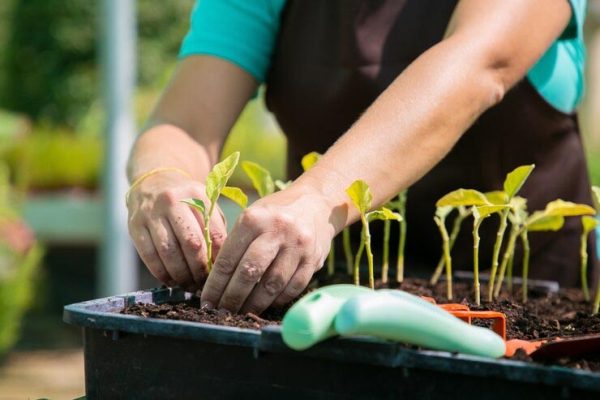
Understanding Factors Leading to Slow Seedling Growth: Common Causes Explored
A gardener wants to witness the transformation of a seed into a seedling. Therefore, they patiently wait for the seeds to germinate after sowing. However, many times, even when the seedling has emerged, its growth could be much faster. In such instances, as a gardener, we feel a sense of disappointment. Sometimes, we resort to fertilizers or other measures to accelerate the growth.
Growing healthy and robust seedlings is crucial in successful gardening and agriculture. However, if you’ve noticed that your seedlings are not thriving as expected, several factors could contribute to their slow growth. This blog will delve into common reasons behind sluggish seedling development and explore ways to address these issues for a more flourishing garden.
Understanding Factors Leading to Slow Seedling Growth
- Inadequate Light Exposure
- Transplant Shock
- Improper Watering Practices
- Inadequate Nutrients
- Poor Soil Quality
- Incorrect Temperature Conditions
- Crowded Seedlings

Inadequate Light Exposure:
One of the primary reasons for slow seedling growth is insufficient light exposure. Seedlings require ample light for photosynthesis, the process by which they convert light into energy. If your seedlings are not receiving enough light, they may become weak and leggy. Consider providing them with additional light through artificial lighting sources or placing them in a location with better natural light.
Also Read This : Transplanting Seedlings: Knowing When and How to Move from Seed Tray to Garden or Containers
Transplant Shock:
One of the primary reasons behind the slow growth of seedlings can also be attributed to transplant shock. Often, seedlings are transplanted too quickly or in stressful conditions, leading to transplant shock. In such cases, they may experience a direct impact on their growth, and as a result, they do not thrive as expected.
Also Read This : Effortless Elegance: Low-Maintenance Succulents Perfect for Indoor Gardens
Improper Watering Practices:
Watering is a delicate balance when it comes to seedlings. Both overwatering and underwatering can hinder their growth. Overwatering can lead to root rot, while underwatering can cause stress and stunted growth. Ensure that you follow a consistent watering schedule and pay attention to your seedlings’ moisture needs.
Also Read This : Know how to grow succulent plants in your home garden? Here are the tips
Inadequate Nutrients:
Seedlings require specific nutrients to thrive, and lacking essential nutrients can impede their growth. Make sure you are using a well-balanced and appropriate fertilizer for your seedlings. Additionally, consider enriching the soil with organic matter to provide a more nutrient-rich environment for optimal growth.
Also Read This : Hibiscus Happiness: A Guide to Caring for Your Plant
Poor Soil Quality:
The soil quality plays a significant role in the growth of seedlings. Compacted or poorly aerated soil can restrict root development and nutrient absorption. Conduct a soil test to assess its composition and make amendments as necessary to create a healthy and crispy growing medium for your seedlings.
Also Read This : Meet the Green Guardians – Houseplants live for Over a Century
Incorrect Temperature Conditions:
Seedlings are sensitive to temperature fluctuations. Exposure to extreme temperatures, whether too hot or cold, can hinder their growth. Ensure your seedlings are kept in stable and suitable temperature conditions. Consider using heat mats or providing shade when necessary.
Also Read This : From Feng Shui to Oxygen Boost: The Multi-Faceted Benefits of Snake Plants
Crowded Seedlings:
Overcrowding seedlings in containers or seed trays can lead to competition for light, water, and nutrients. Transplant seedlings into larger containers as they grow to provide ample development space.
Also Read This : Easy and Budget-Friendly Herb Propagation from Cuttings
Here are some quick tips to ensure the flourishing growth of your seedlings:
Once your seedlings have developed 2-3 sets of leaves, providing them with supplemental nutrients becomes crucial. Most seed-starting mixes contain minimal or no nutrition. We recommend using ¼ to ½ strength liquid fish/seaweed fertilizer every other watering to ensure your seedlings receive the necessary nutrients for optimal growth.
Choosing a soilless seed starting mix is essential for starting seeds. Soilless mixes are lightweight, fluffy, and ideal for promoting strong and sturdy root development in your seedlings. Garden soil or potting soil is often too heavy and needs proper drainage, which can be challenging for the delicate root systems of young seedlings. Therefore, a soilless mix creates a favourable environment for healthy seedling growth.
Also Read This : Rapid Aloe Vera Growth: Essential Tips for Quick Thriving
Understanding the factors contributing to slow seedling growth is the first step towards fostering a healthy and vibrant garden. By addressing issues such as inadequate light, improper watering, nutrient deficiencies, poor soil quality, temperature extremes, and overcrowding, you can create an optimal environment for your seedlings to thrive. Implementing these corrective measures will enhance the growth of your current seedlings and set the foundation for a flourishing garden in the coming seasons.




